Astronomy and art collide at ‘The Immersive Power of Light’ Exhibition
2 Sep 2024
Macquarie University Art Gallery has unveiled its latest exhibition, ‘The Immersive Power of Light,’ running from 16 August to 27 September 2024.
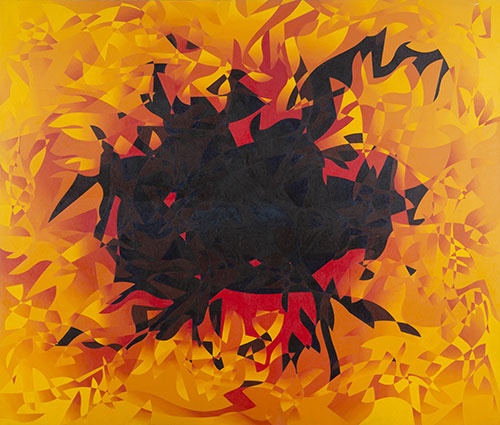 The Sun, 2005 - Tom Loveday
The Sun, 2005 - Tom Loveday
Curated by Rhonda Davis, Leonard Janiszewski and Andrew Simpson, the exhibition features 40 works by 18 artists, all exploring the multifaceted nature of light through different artistic mediums.
‘The Immersive Power of Light’ features both contemporary and historical artworks and provides a platform for dialogue between artistic expression and scientific inquiry. The exhibition invites viewers to consider the multifaceted nature of light and its impact on human perception and understanding of the universe.
“We have pulled together a collection that works really well in our art gallery space, all of these addressing ideas around different types of light,” says Davis.
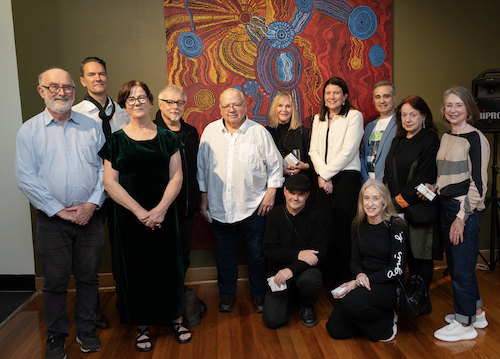 Artists and curators at the launch of The Immersive Power of Light, August 2024
Artists and curators at the launch of The Immersive Power of Light, August 2024
Striking space
The University’s Gallery is a striking space. Cleverly placed interior walls create several small partly-hidden corridors ideal for exhibiting certain judiciously-placed works.
During the day, works shown on the expanse of white walls in the main gallery space respond to natural light shining through the tall windows overlooking Macquarie’s lake and the beautiful Chancellery surrounds.
There’s a different feel in the gallery at night, when the bright overhead gallery lights shining down on the space are also reflected in the rich gloss of timber floors.
The exhibition was designed to align with the University’s Astronomy Open Night on 21 September, and to bridge the gap between artistic expression and scientific inquiry.
This synergy offers visitors a unique opportunity to experience the interplay between art and astronomy.
Artists and light
A centrepiece of the exhibition is the interactive installation Plato's Cave by Australian artist Ian Milliss, who has been active since the late 1960s, and is known for his innovative use of everyday materials and audience engagement.
“Ian wants people to get involved in art, not just look at stuff on the wall,” says Davis, who has known the artist for many years. “He uses what he terms ‘anti-art material’ – meaning everyday items you can use or buy at a regular hardware store.”
In Plato’s Cave, Milliss picked up a lamp on a stand from Bunnings, used one of the gallery benches, and created a mural on the gallery wall.
“The work is about shadow and the way the light casts different shadows on the silver wall,” says Davis. She says the interactive nature of the piece is crucial.
“If a person sits on the gallery bench looking at this silver motif on the wall, and someone takes a photo of them, the interplay of light and shadow creates an almost spiritual aura of light around their silhouette.”
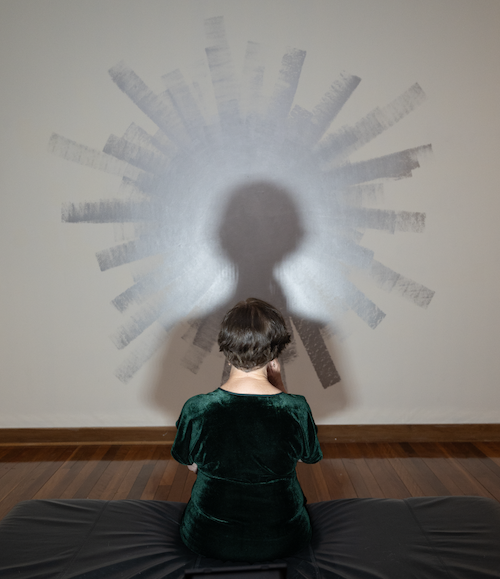
Plato's Cave, Ian Milliss 2024
Artist Paula Dawson is a pioneer in working with light, famously using laser to create the largest-ever single hologram in 1980, titled ‘There is no place like home,’ since restored and now part of Macquarie University's permanent art collection.
Dawson moves away from her technological experiments with light in her contribution to this exhibition, however, with the ‘Mystery’ series, watercolour pieces that delve into complex astronomical concepts using traditional media.
“She’s using simple materials to still talk about the universe,” says Davis.

Mystery, Paula Dawson 2021-2022
More universal themes
The exhibition’s diverse range of media includes paintings, sculptures, and interactive installations.
Aboriginal art is also represented, through three works by Anmatyerre women Gabriella Possum Nungurrayi and Michelle Possum Nungurrayi, part of Macquarie University’s permanent art collection.
Vibrant paintings from these two artists titled ‘Seven Sisters Dreaming,’ weave traditional storytelling with celestial imagery, offering a unique perspective on the exhibition's theme.
Miguel Olmo’s piece ‘Harbinger,’ brings a contemporary edge to the show. His work displays AI-generated images using a vintage slide projector, creating an intriguing dialogue between cutting-edge technology and obsolete presentation methods.
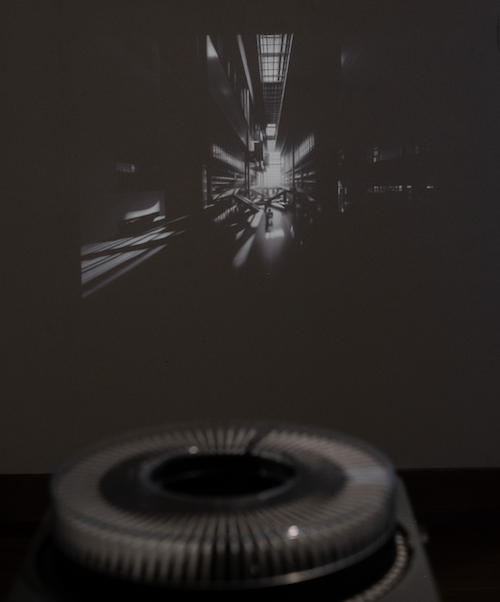
Harbinger (2024) - Miguel Olmo
From the university’s permanent collection, a piece by Australian art legend Frank Hinder (1906-1992) takes centre stage. ‘Universe 11’ is a recently-restored kinetic sculpture from the 1980s featuring moving lights that mimic celestial movements.
“It’s a striking piece, from the bottom of the dome you can see a cluster of the sky and the planets,” says Davis.
Other notable contributions include four works by Giles Alexander, exploring light and reflection, and 13 intricate prints by Roslyn Kean, demonstrating the interplay of light and shadow in woodblock art.
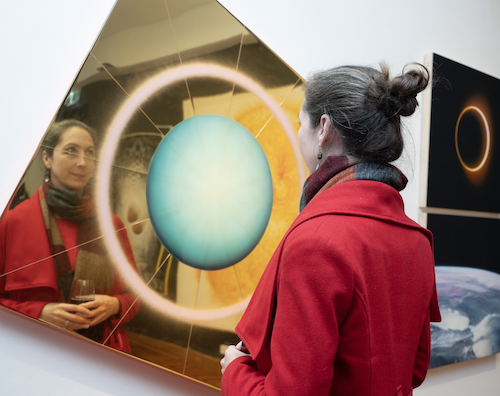
Eccentric Action Painting #14, Giles Alexander (2019)
“This show brings together different fields in a way that’s uniquely Macquarie,” says Davis.
“It gives our students, staff, and the public a chance to get their heads around some complex scientific ideas through the eyes of artists. It’s a bit like looking at the universe through a different lens – you might just see something you’ve never noticed before.”
The University Art Gallery will welcome visitors during the Astronomy Open Night on 21 September from 5-10pm, offering a unique after-hours experience of the artworks alongside astronomical activities.
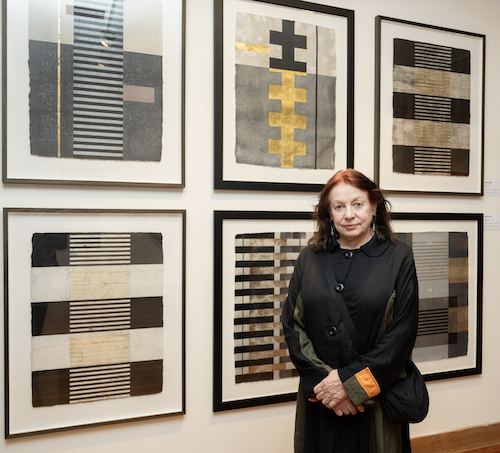
Multi block woodcuts, Roslyn Kean, 2014-16
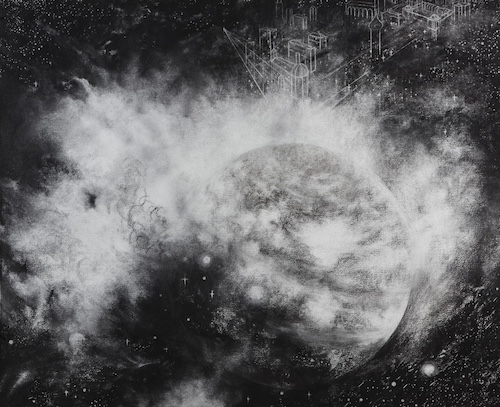 A new heaven and a new Earth, Jennifer Keeler-Milne, 2018
A new heaven and a new Earth, Jennifer Keeler-Milne, 2018
Photographs by Effy Alexakis, Photowrite